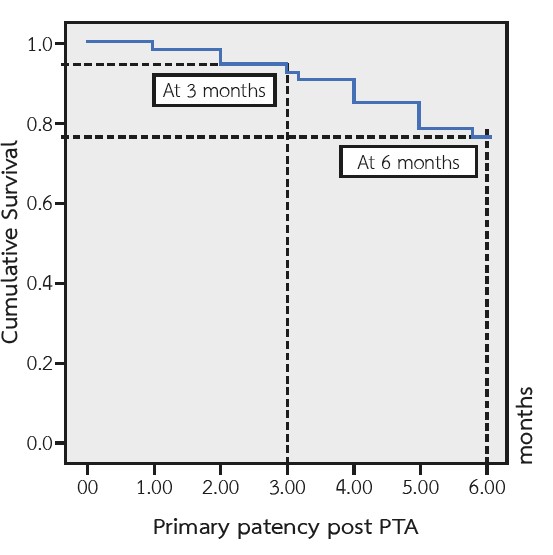Prognostic Factors of Patency Loss of Arteriovenous Fistula After Percutaneous Transluminal Angioplasty
Main Article Content
Abstract
Introduction: Arteriovenous fistula (AVF) is recommended as 1st choice of vascular access for hemodialysis (HD). Percutaneous transluminal angioplasty (PTA) helps increase the patency of AVF, which enhances HD adequacy. However, a slow decline in blood flow rate over time after PTA is common. The present study examined factors associated with patency loss at 6 months after PTA.
Method: This is a single-center prospective cohort study of 54 HD patients using AVF as dialysis access. Demographic data and characteristics of AVF were collected at baseline. The changes in blood flow rates after PTA were recorded immediately and at 3- and 6-month after the procedure. Factors associated with patency loss at 6 months after PTA were evaluated.
Results: The average age of AVF was 77.1 ± 68.4 months. Sixty-three percent of the fistula were in the upper arm. Central vein stenosis was present in 15.3%. Forty-six percent had previous interventions to the fistula. The most common type of intervention was plain balloon angioplasty (90.7%). The access blood flow rate (ABF) rate improved significantly immediately after the PTA. However, a slow but significant decline in ABF rate was observed at 3 and 6 months. The patency rates of the fistula at 3 and 6 months were 94.4% and 75.9 %, respectively. Independent predictors for patency loss at 6 months were ABF <500 ml/min immediately after the procedure, multiple stenotic lesions, and higher PTH level. Higher hemoglobin and lower ABF rate immediately after the PTA were independently correlated with >25% decline in the ABF at follow-up
Conclusion: Low ABF rate immediately after PTA, higher number of stenotic lesions, and higher PTH level predicted patency loss of AVF after PTA. These findings could help identify patients at high risk of AVF failure who might benefit from close monitoring.
Article Details

This work is licensed under a Creative Commons Attribution-NonCommercial-NoDerivatives 4.0 International License.
This article is published under CC BY-NC-ND 4.0 license, which allows for non-commercial reuse of the published paper as long as the published paper is fully attributed. Anyone can share (copy and redistribute) the material in any medium or format without having to ask permission from the author or the Nephrology Society of Thailand.
References
Asif A, Roy-Chaudhury P, Beathard GA. Early arteriovenous fistula failure: a logical proposal for when and how to intervene. Clin J Am Soc Nephrol. 2006;1(2):332-9
Vascular Access 2006 Work Group. Clinical practice guidelines for vascular access. Am J Kidney Dis. 2006;48 Suppl 1:S176-247.
Hassan, M.H., Abdelrazek, G.M. & Hashim, A.A. The clinical importance of color Doppler ultrasonography in puncture related complications of hemodialysis vascular access. Egypt J Radiol Nucl Med. 2019;50:89
Lok CE, Huber TS, Lee T, Shenoy S, Yevzlin AS, Abreo K, et al. National Kidney Foundation. KDOQI Clinical Practice Guideline for Vascular Access: 2019 Update. Am J Kidney Dis. 2020;75(4 Suppl 2):S1-164.
Wongwanit C, Simasinha T, Mutirangura P, Raungsetakit C, Chinsakchai K, Sermsathanasawadi N, et al. Patency of Stenotic Arteriovenous Fistula (AVF) after Percutaneous Balloon Angioplasty (PTA). J Med Assoc Thai. 2017;100(5):154
Visesluk S. Vascular access blood flow rate by ultrasound dilutional technique in hemodialysis patients. Thai Thesis Database. 1999;72
Huijbregts HJ, Bots ML, Wittens CH, Schrama YC, Moll FL, Blankestijn PJ. CIMINO study group. Hemodialysis arteriovenous fistula patency revisited: results of a prospective, multicenter initiative. Clin J Am Soc Nephrol. 2008;3(3):714-9.
Romann A, Beaulieu MC, Rhéaume P, Clement J, Sidhu R, Kiaii M. Risk factors associated with arteriovenous fistula failure after first radiologic intervention. J Vasc Access. 2016;17(2):167-74.
Manou-Stathopoulou S, Robinson EJ, Harvey JJ, Karunanithy N, Calder F, Robson MG. Factors associated with outcome after successful radiological intervention in arteriovenous fistulas: A retrospective cohort. J Vasc Access. 2019;20(6):716-24.
Neuen BL, Gunnarsson R, Baer RA, Tosenovsky P, Green SJ, Golledge J, et al. Factors associated with patency following angioplasty of hemodialysis fistulae. J Vasc Interv Radiol. 2014;25(9):1419-26.
Heerwagen ST, Hansen MA, Schroeder TV, Ladefoged SD, Lönn L. Endovascular Treatment of Hemodialysis Arteriovenous Fistulas: Is Immediate Post-Interventional Blood Flow a Predictor of Patency? J Vasc Access. 2012;13(3):315–20.
Gardezi AI, Karim MS, Rosenberg JE, Scialla JJ, Banerjee T, Powe NR, et al. Markers of mineral metabolism and vascular access complications: The Choices for Healthy Outcomes in Caring for ESRD (CHOICE) study. Hemodial Int. 2020;24(1):43–51.
Zheng Q, Xie B, Xie X, Zhang W, Hou J, Zhonglin F, et al. Predictors associated with early and late restenosis of arteriovenous fistulas and grafts after percutaneous transluminal angiography. Ann Transl Med. 2021 ;9(2):132.
Kim Y, Kim HD, Chung BH, Park CW, Yang CW, Kim YS. Clinical predictors of recurrent cephalic arch stenosis and impact of the access flow reduction on the patency rate. J Vasc Access. 2022;23(5):718


